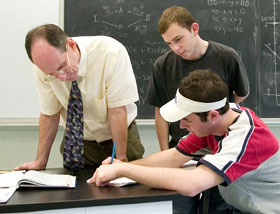  |
| HOME | THIS ISSUE | CALENDAR | GRANTS | BACK ISSUES | < BACK | NEXT > |
Award-winning professor shares ‘joy of math’ with studentsby Scott Brinckerhoff - October 31, 2005 |
||||
|
In his first classes each semester, math professor Stuart Sidney goes around the room and asks students to state their names, where they live, and one random fact about themselves that others might find curious. The exercise is an icebreaker, but it has an additional purpose: to let students identify classmates who live near them and might be good study partners. As for Sidney, his random fact is that three of his four children have the same birthday, in different years. That quirk might form the basis for a classroom exercise in probability, but it doesn’t. Sidney’s teaching is largely in pure mathematics, a world of polynomials, coefficients, daunting equations, and logarithms – subject matter that does not lend itself readily to real-life examples. Sidney’s students may not emerge from his calculus, advanced algebra, or graduate level analysis courses with techniques for beating the house at Foxwoods, but they do leave with a sense of satisfaction and a healthy respect for their professor. That’s why he won the Alumni Association Award for Excellence in Teaching at the graduate level this year. Sidney struggles a bit when asked about the meaning of his recognition. “I guess it has to do with the kindness of students who have treated me well in their ratings,” he says. “But as far as I know, nobody has ever sat down and determined exactly what these ratings measure. So I don’t know whether I’m a good teacher in some measurable sense, but I do know that my students know I’m on their side.” A visit to his calculus class seems to confirm that. Affable and approachable, Sidney fields questions from students and begins to construct equations on a chalk board. Like a storyteller, he shakes a finger at his audience now and then to punctuate a point: “If you do that, you get an algebraic miracle,” or “By now, you could probably get the answer mentally, with a little cogitation.” He calls on students by name and encourages participation with a “Did you all follow that?” or “Are you with me?” at crucial junctures. He believes there are no dumb questions. “If a student gives kind of a wild response to a question from me, that’s okay. I don’t dismiss it out of hand, because there is usually something there worth talking about.” Sidney’s written ratings from students are strewn with encomiums: “Material was well-organized, very interesting, and taught well.” “Class was fun and informative.” “Everything was explained clearly.” “Awesome explaining skills. Enjoys math.” “Stimulated interest. Taught with passion and pointed out the beauty of the mathematics rather than just giving the facts.” Sidney says he teaches process, then product, meaning that he first emphasizes how to approach a problem. “Think about the math and how you’re going to tackle the problem, I tell students. Then focus on the actual tools,” he says.
Asked what qualities make a teacher excellent, Sidney replies, “There are no magic bullets, but I think any teacher should walk into the classroom knowing the subject they’re about to teach. So be ready intellectually.” He adds, “Second, teaching should bring obvious joy to the teacher. Years ago, I noticed that some teaching assistants would be in class looking like they were getting their teeth drilled. I told them their joy of math should show, not look as though it’s agony.” Sidney’s students are occasionally treated to forays into math history, where they meet prodigies reminiscent of Russell Crowe’s character in “A Beautiful Mind” or the Matt Damon hero in “Good Will Hunting.” One of Sidney’s favorites is Srinivasa Ramanujan, a man who lived in the early 20th century and was widely regarded as India’s greatest mathematician. Another is Leonard Euler, an 18th century Swiss whose name is as familiar to mathematicians as Hemingway’s is to students of American literature. Euler produced 886 papers and 13 children, and even after becoming blind was said to be able to perform astonishing calculations in his head, bouncing a child on his lap as others played loudly around him. A good grounding in math helps students see things intuitively, Sidney says. “When I look at media reports on something quantitative, I see them differently than a non-mathematician,” he says. “For example, if a company reports that its earnings doubled, it might provide a three-dimensional graphic that to me would actually represent an eightfold increase. To me, the graphic is a clear misrepresentation.” This ability to “think spatially” has served Sidney well since his youth, when his talent for geometry led him to construct model airplanes without using kits. Many years later on vacation, he displayed similar skill in guessing the number of beans in a jar, after constructing a quick algorithm in his head. “My estimate was way higher than anyone else’s,” he recalls. “But it was by far the closest.” |
| ADVANCE HOME UCONN HOME |

